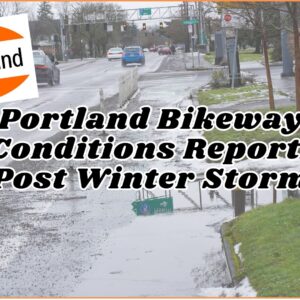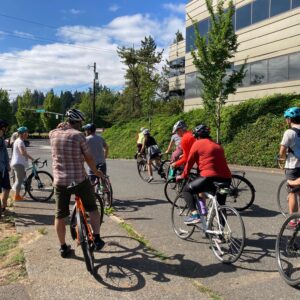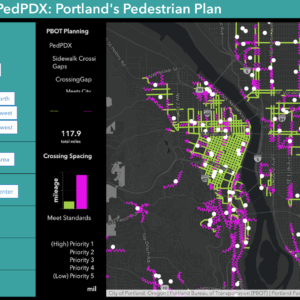I’m a bit late in posting this, but here’s the Bureau of Transportation’s storm update for Monday, 12/22 (read it online here):
Released: December 22, 2008
Contact: Cheryl Kuck, 503-823-5909
PUBLIC URGED TO AVOID UNNECESSARY TRAVEL
Icy roads and continuing inclement weather present challenges to road crews, transit providers, and travelers
(PORTLAND, OR) – Severe winter weather conditions continue to affect the Portland metropolitan region since an arctic air mass entered the area last Sunday, December 14. According to the National Weather Service, this is the worst winter storm to hit the Portland metropolitan region since 1968. This prolonged winter storm event has brought to the region extremely cold temperatures, strong winds, freezing rain, sleet, snow showers, and heavy accumulations of snow and ice on streets and highways. Driving is treacherous.
The public is advised as follows:
* Avoid unnecessary travel
* Use mass transit rather than driving
* Stay tuned to local weather forecasts and traffic advisories
* Use traction tires or chains if driving is necessaryCity crews have been working around the clock since Sunday to keep priority routes open for commerce and mass transit. Crews today are focusing on plowing transit routes, emergency response routes, bridges, overpasses, major arterials, and some collector streets. Limited sanding is occurring due to it bouncing off icy streets or simply being swallowed up by snow.
With more snow showers expected off and on throughout the week and with temperatures dropping below freezing at night, snow and ice will stay on the ground and road surfaces. With significant warming not expected until late in the week, conditions will remain hazardous. The public is advised to expect icy, snow-packed roads for several days. Transportation officials warn the public that it will be a slow transition out of this storm.
Chains Recommended on Portland Streets
Although not a requirement, the City of Portland does strongly recommend vehicles use chains or traction tires on City streets. The Oregon Department of Transportation is still requiring chains on all vehicles driving on state roads in the Portland area, except non-towing 4WD and all-wheel drive vehicles equipped with mud-and-snow tires or all-weather tires on all four wheels.
Advise to Motorists
Motorists are advised as follows:
* If possible, park you car off-street to allow snow plows to remove snow for the general public and emergency vehicles; plowing activity could trap you in.
* If driving downtown, consider parking in a SmartPark garage in lieu of on-street parking to allow for public and private snow removal.
* If you have trouble, move your vehicle to as far to the right of the road as possible and call for service or a tow truck immediately; do not abandon your vehicle.Transit Options
TriMet buses and MAX light rail are continuing to operate, although they are experiencing difficulty in these wintry conditions. Frozen switches are causing service disruptions on MAX lines. Shuttle bus frequency is now averaging about every 15 minutes. The Portland Streetcar is continuing to operate around the clock, picking up passengers at stops all hours. A continuous operation keeps ice off overhead wires.
TriMet announced at noon today that they would reduce service on lines affected by weather conditions. Frequent service lines and routes operating on passable streets will remain in service. According to TriMet officials, those routes represent only 27% of their total routes but 76% of their regular customers. City transportation crews will work through the night to try to make all transit routes more passable.
Call 503-238-RIDE (7433) for TransitTracker information for TriMet buses, MAX light rail, and the Portland Streetcar. For some bus routes TransitTracker may have difficulty projecting how many minutes remain before the bus arrives at your stop. When this happens, it will instead tell you how far away the bus is from your stop. Visit www.TriMet.org for service alerts.
Clearing Sidewalks and Driveways
Property owners are advised that they are responsible for maintaining their sidewalks, including the removal of snow and ice. The City requires property owners to clear their sidewalks with a three-foot-wide path as soon as possible after a snow event. Many people are walking to get around Portland in these wintry conditions. Some pedestrians are walking in the street because sidewalks are impassable. Please help make sure pedestrians and transit users have a place to walk safely.
Property owners are also responsible for clearing their own driveways. City crews will not respond to requests for plowing and sanding residential neighborhood driveways. The City understands the inconvenience of having to shovel snow that plows have pushed aside at the curb and at driveways, but those conditions are unavoidable. Plowing simply pushes the snow aside – it doesn’t remove the snow or melt the snow.
Where the Plows Are
Because winter storms are so rare in our area, the City has a limited fleet of vehicles for plowing and sanding and they are focused on the higher priority facilities:
*
Pre-identified hazard areas and critical locations (bridges, overpasses, and critical known problem areas)
*Primary routes to include major arterial streets to support transit and lifeline routes, which serve hospitals and other key emergency facilities
*Secondary routes to include additional arterial streets with a high daily traffic count and major collector streets
The City understands the public’s frustration with current road conditions due to heavy snowfall and ice formation. The City also appreciates the public’s understanding that crews are doing the best they can under extremely challenging conditions. Portland is not a Denver, Chicago, or Minneapolis; does not get a “predictable” annual snowfall; cannot afford to purchase equipment that would simply sit idle in the yard most of the year perhaps for years.
Portland has widely varying terrain and can have widely varying weather conditions throughout the city. It is not uncommon to have a significant amount of snow accumulation in one part of the city while only a few miles away there is no snow at all or just ice. Hills on both the east and the west sides of the city increase motorists’ difficulties and require special attention from Transportation crews.
In this severe winter weather event, for example, the snow has continued to fall at all elevations. There also is a temperature gradient that prevents the plows from cutting very much snow and ice accumulation off at one time. As temperatures moderate, crews will be able to remove more snowpack with plows.
Plowing is a road treatment designed to make a firmer driving surface for vehicles. When a plow comes through, it pushes aside snow and slush. As vehicles drive through behind the plow, they compact the snow more, snow falls off vehicles, and traffic adds more slush to the road. A plow can only cover eight feet of a lane at any given time; therefore, it takes a plow numerous passes to effectively treat one route.
City equipment plows to leave an ideal depth of one inch or so of packed snow on the road – just thin enough that when it melts it’s not too heavy, and thick enough that it does not turn into a sheet of ice. In a citywide street system of 4,000 miles, crews plow and sand 1,300 miles. Today’s shift included 52 plows traveling between 5-10 mph, each plowing about 25 miles of street. It’s a slow operation in extremely challenging conditions.
In current conditions, it may take crews a full 12-hour shift just to plow primary routes; therefore, many secondary routes may receive limited service. Crews will not respond to requests for sanding and plowing of residential neighborhood streets. To view the City’s sanding and plowing routes map, visit www.TripCheck.com for the Portland region and click on the link to Portland Winter Travel Info.
Transportation officials all around the region are facing similar challenges – crews working long hours, dwindling supplies of de-icing materials, down equipment, and extremely challenging weather conditions. Essentially, everything crews do is a temporary treatment under these weather conditions. Crews plow, get another heavy snowfall, plow more, get another heavy snowfall, de-ice, get another freeze, de-ice, get another freeze, and so on.
A Word on Budget
Transportation’s FY 08-09 budget includes one million dollars in contingency for any type of emergency response – snow and ice, flood, fire, or natural disaster. Obviously, needs vary considerably from year to year. Budget impact for severe or prolonged events can be significant. It can more than double the City’s normal operating expenditures for a day.
With this current severe winter weather event – an event that has had a series of systems in just a week’s time – Transportation will certainly exceed that budget.
Transportation’s primary source of discretionary operating revenue is the State Highway Trust Fund, the “gas tax.” The main components of Highway Trust Fund revenue are motor fuels tax, weight-mile tax, and vehicle registration and titling fees. Since none of these sources is indexed to inflation and with vehicles becoming more fuel efficient and more people using transportation alternatives to the one-person occupancy vehicle, discretionary revenues are projected to be declining in coming years.
There is a wide gap between the maintenance and safety needs of Portland’s transportation system and the City’s resources to meet those needs. Simply reallocating resources will not close that gap. In addition, Transportation cannot rely on reserves to fund short-term budget gaps or support costs due to emergencies such as landslides, floods, and this current unusual snow and ice event.
As Mayor-Elect Sam Adams’s “Safe, Sound, and Green Streets” program emphasized, Transportation has at a minimum a $422 million maintenance backlog in addition to roughly one-half billion dollars deferred road maintenance. This backlog will continue to grow and have a serious impact on Portland’s transportation system until we are successful in securing new and sustainable funding sources for our maintenance operations and safety programs.
Social Services
This prolonged severe winter weather has impacted vulnerable individuals and families living on the streets. Anyone seeking shelter should contact 211Info by dialing 2-1-1. 211Info will be available to identify available shelter and warming centers.
City Employees
At 1:22 p.m. today, Mayor Tom Potter announced that all City offices are closed effective immediately due to worsening weather conditions and TriMet’s reduction in transit service. All non-essential employees were released from work. All employees who reported to work today will be paid for their entire work day. Employees who did not come to work today must follow the City’s inclement weather policy and use accrued leave to cover their absence. Information will be available at 6:00 a.m. tomorrow concerning the status of City offices and whether the City will be closed. Please check www.PortlandOnline.coom or the City’s information number at 503-823-4000 tomorrow morning for the latest update.
Road Closures Due to Icy, Dangerous Conditions
1. SW Bertha Ave from SW Council Crest Dr to Fairmount Blvd
2. SW McDonnell Terrace from SW Council Crest Dr to Fairmount Blvd
3. SW Hall St from SW Upper Hall to Cardinell
4. SW 20th from SW Salmon St to Morrison
5. SW 30th from W Vermont to Beaverton Hillsdale Hwy
6. SW 44th at SW Patton Road
7. NW Pinnacle at NW Thompson
8. NE Wisteria from NE 39th to 42nd
9. NE Gilham from E Burnside to NE Davis
10. NE Multnomah from Peerless Pl to Imperial Ave
11. SE 112th Ave from SE Brookside Dr to Mt. Scott Blvd
12. SE 122nd Ave from SE Foster Road to Flavel St





Thanks for reading.
BikePortland has served this community with independent community journalism since 2005. We rely on subscriptions from readers like you to survive. Your financial support is vital in keeping this valuable resource alive and well.
Please subscribe today to strengthen and expand our work.